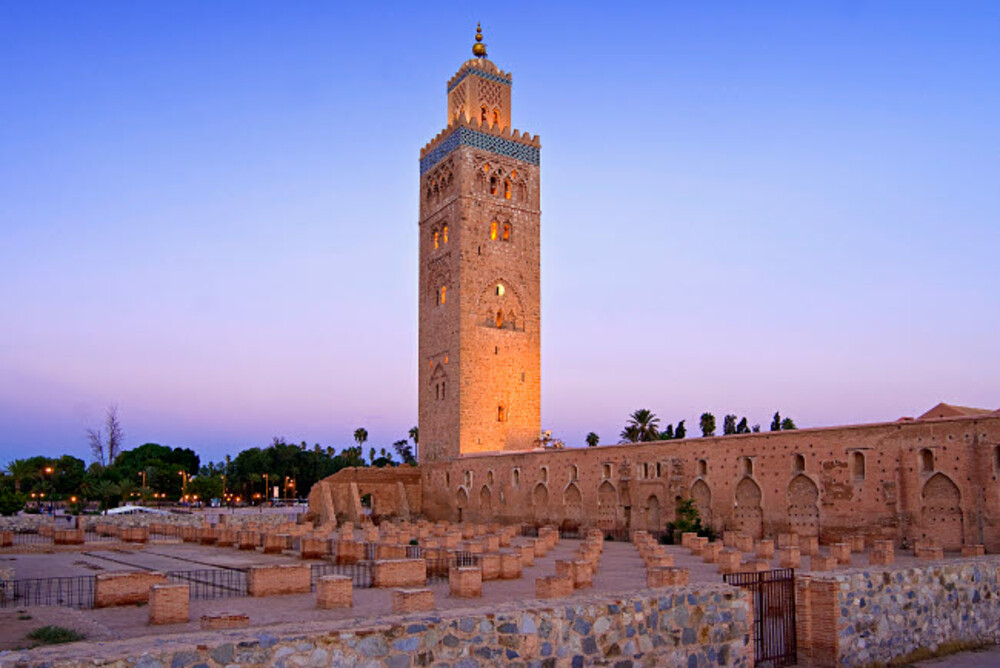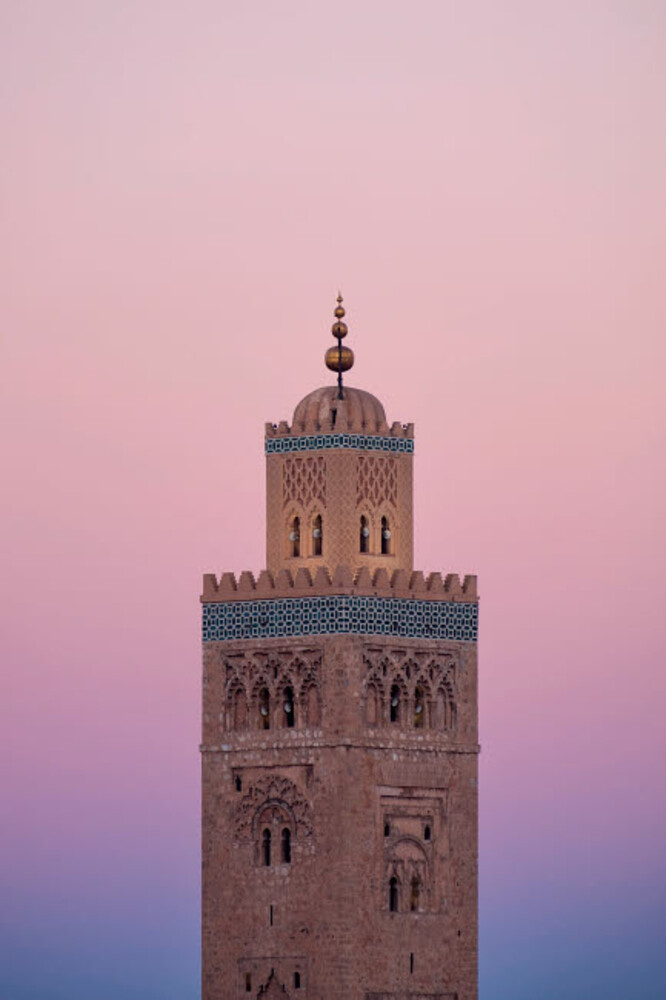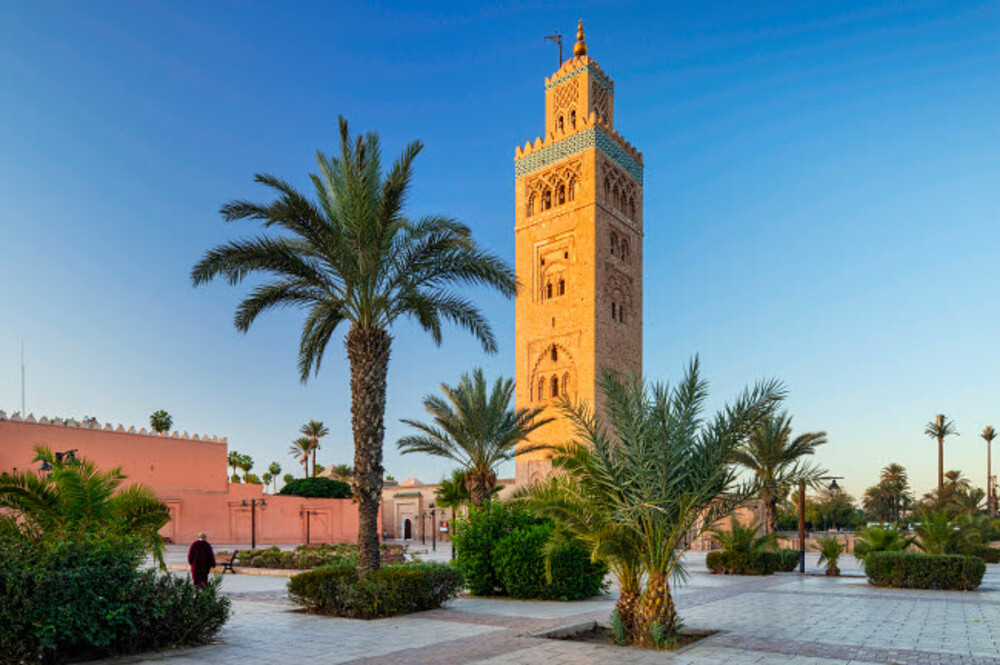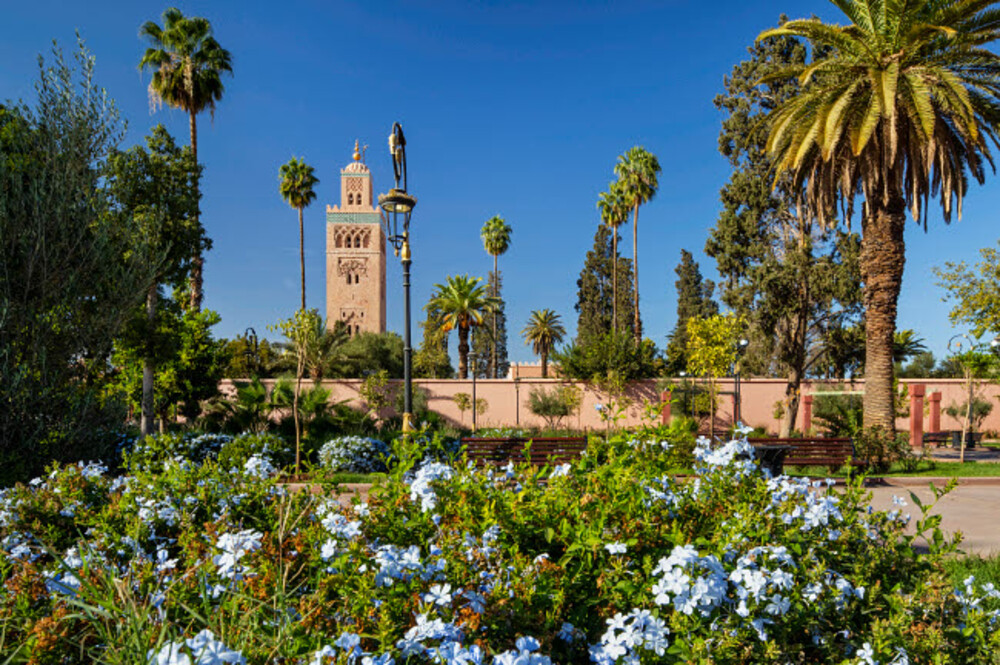Introduction
The Majestic Koutoubia Mosque, an architectural marvel nestled in the heart of Marrakech, stands as a testament to the city’s rich cultural heritage and Islamic legacy. Its towering minaret, intricate design, and historical significance make it a symbol of Morocco’s spiritual and architectural prowess.
Unveiling the history

The majestic Koutoubia Mosque stands as a testament to the rich history of Islamic architecture, dating back to the 12th century under the rule of the Almohad Caliphate. Its creation was commissioned by Sultan Abd al-Mu’min, marking the dawn of an era of grandeur and cultural flourishing. Construction began in 1150 CE, a monumental undertaking that culminated in its completion in 1199 CE, a span of nearly five decades.
The mosque’s name, “Koutoubia,” originates from the bustling book markets that once thrived in its vicinity, symbolizing not only a place of worship but also a hub of knowledge and intellectual exchange. Its towering minaret, reaching a height of over 77 meters, dominates the skyline of Marrakech, serving as a beacon of faith and architectural splendor.
The design of the Koutoubia Mosque embodies the distinctive features of Almohad architecture, characterized by its use of geometric patterns, ornate stucco work, and intricate calligraphy adorning its walls and ceilings. Its expansive prayer hall can accommodate thousands of worshippers, fostering a sense of community and devotion. Over the centuries, the mosque has stood as a resilient symbol of faith, surviving numerous challenges and embodying the enduring legacy of Islamic civilization.
Architectural marvels


The grand minaret : The Majestic Koutoubia Mosque boasts a distinctive minaret that dominates the skyline at an impressive 77 meters tall. Crafted from red sandstone, its façade showcases intricate geometric designs, a hallmark of Islamic artistry. This towering structure not only serves as a place of worship but also symbolizes the rich architectural heritage of Marrakech. Its commanding presence is visible from different corners of the city, offering a timeless reminder of the city’s Islamic legacy. As an iconic landmark, the minaret of The Majestic Koutoubia Mosque stands as a testament to the cultural significance and grandeur of Moroccan architecture.
Courtyard and prayer hall: Entering the mosque’s courtyard reveals a peaceful sanctuary adorned with lively gardens and graceful fountains, offering a serene escape from the city’s hustle. The prayer hall, embellished with marble columns and intricately carved ceilings featuring Islamic motifs, emanates a sense of spiritual reverence. Each detail, from the lush greenery to the ornate architecture, fosters a tranquil atmosphere conducive to contemplation and prayer. This sacred space invites visitors to immerse themselves in the beauty of Islamic artistry and find solace amidst the chaos of urban life.
Decorative elements: In the mosque, every corner showcases the mastery of Andalusian and Moorish artisans through intricate stucco carvings, vibrant mosaic tiles, and ornate calligraphy. These elements, meticulously crafted, reflect a rich tapestry of cultural fusion and artistic brilliance. Each detail, whether it’s the mesmerizing geometric patterns or the eloquent Arabic inscriptions, carries a narrative of historical significance and aesthetic splendor. The blend of styles and motifs narrates a tale of diverse influences and harmonious coexistence, highlighting the depth of craftsmanship and the cultural legacy of the region.
Cultural significance
The Majestic Koutoubia Mosque, with its striking architectural grandeur, stands as an emblem of Marrakech’s cultural heritage and holds profound significance for Morocco. Beyond its physical beauty, the mosque serves as a spiritual hub, drawing Muslims worldwide to its sacred precincts. Its towering minaret, reaching towards the heavens, symbolizes not only the city’s skyline but also the devout faith of its people.
Built during the Almohad dynasty, the mosque is a testament to the rich Islamic heritage that permeates Moroccan culture. Its intricate geometric patterns, exquisite tile work, and elegant arches showcase the mastery of Islamic art and architecture, inspiring awe and reverence in visitors.
Moreover, the Koutoubia Mosque embodies the resilience and endurance of Moroccan identity amidst changing times. It stands as a reminder of the country’s historical legacy, evoking a sense of national pride and unity among Moroccans. As a focal point for communal gatherings and religious rituals, the mosque plays a vital role in fostering social cohesion and spiritual nourishment within the local community. Its presence not only enriches Marrakech’s skyline but also enriches the hearts and minds of those who come to worship within its walls.
The majestic Koutoubia mosque

Standing the test of time: The Majestic Koutoubia Mosque, an architectural marvel, has weathered centuries of political tumult and societal changes, remaining an emblem of Marrakech’s unwavering spirit and endurance. This iconic structure, with its towering minaret piercing the sky, serves as a poignant reminder of Morocco’s profound historical legacy and cultural steadfastness. Amidst the modernization sweeping through Marrakech, the mosque’s timeless presence stands as a testament to the resilience of its people and the enduring significance of Islamic heritage. Its majestic silhouette against the city’s evolving skyline reflects the harmony between tradition and progress, ensuring its place as a cherished symbol of identity for generations to come.
Inspiration for artists: Over centuries, the Majestic Koutoubia Mosque has enchanted artists, poets, and writers, inspiring them to immortalize its ethereal charm. Its iconic silhouette, adorned with intricate details, has been a recurring motif in countless paintings and sketches, each attempting to encapsulate its grandeur. Poets have penned verses extolling its magnificence, weaving its presence into the fabric of their verses. Writers, too, have found solace in its serene aura, often incorporating its symbolism into narratives of spiritual journeys or cultural reflections. Across time and geography, this mosque remains a timeless beacon of inspiration, transcending mere architecture to embody spiritual and artistic devotion.
A Symbol of unity: Beyond its religious significance, The Majestic Koutoubia Mosque embodies the spirit of unity and tolerance, welcoming visitors of all faiths and backgrounds to bask in its splendor. As a symbol of Morocco’s multicultural ethos, it fosters dialogue, understanding, and mutual respect, bridging divides and fostering a sense of shared humanity.
Conclusion
In conclusion, The Majestic Koutoubia Mosque stands as a beacon of faith, culture, and heritage, embodying the essence of Marrakech’s storied past and vibrant present. Its timeless beauty, architectural grandeur, and cultural significance make it an indispensable part of Morocco’s cultural landscape, beckoning travelers and seekers alike to experience its allure and mystique.
FAQs
- What is the significance of the name “Koutoubia”? The name “Koutoubia” derives from the Arabic word “koutoubiyyin,” which translates to “bookseller.” It pays homage to the bustling book markets that once surrounded the mosque, serving as hubs of intellectual exchange and scholarship.
- How tall is the minaret of The Majestic Koutoubia Mosque? The minaret of The Majestic Koutoubia Mosque stands at an impressive height of 77 meters, making it one of the tallest structures in Marrakech and a prominent feature of the city’s skyline.
- Who commissioned the construction of The Majestic Koutoubia Mosque? The construction of The Majestic Koutoubia Mosque was commissioned by Sultan Abd al-Mu’min, the founder of the Almohad dynasty, during the 12th century.
- What architectural styles influenced the design of The Majestic Koutoubia Mosque? The design of The Majestic Koutoubia Mosque reflects a fusion of Andalusian and Moorish architectural styles, characterized by intricate geometric patterns, horseshoe arches, and decorative motifs inspired by Islamic art and culture.
- Can visitors enter The Majestic Koutoubia Mosque? While non-Muslims are not permitted to enter the prayer hall for worship, the mosque’s courtyard and surrounding gardens are open to visitors, allowing them to marvel at its architectural splendor and soak in its spiritual ambiance.
- Is The Majestic Koutoubia Mosque still used for daily prayers? Yes, The Majestic Koutoubia Mosque remains an active place of worship, where Muslims gather for daily prayers, Friday sermons, and special religious occasions, perpetuating its centuries-old tradition of spiritual devotion and communal harmony.



